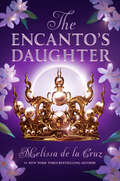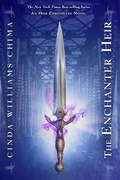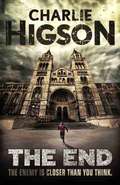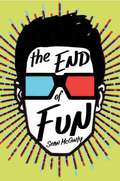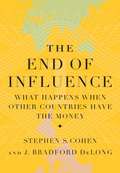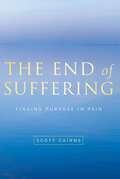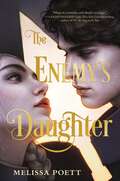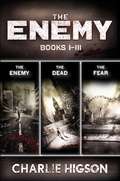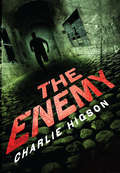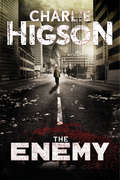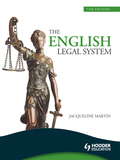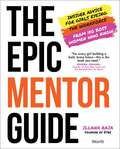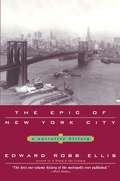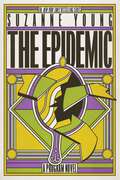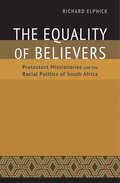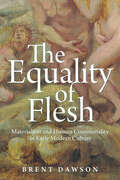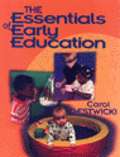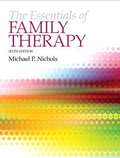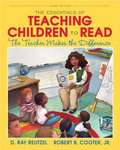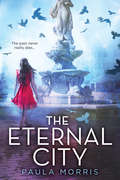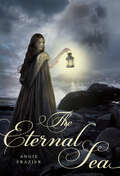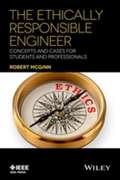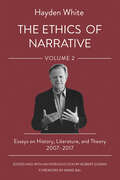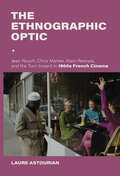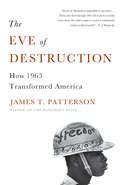- Table View
- List View
The Encanto's Daughter (The Encanto's Daughter #1)
by Melissa de la CruzA young woman claims the throne of a realm inspired by Filipino mythology in this YA romantic fantasy, the first in an enchanting new duet by #1 New York Times bestselling author Melissa de la Cruz.MJ Rodriguez has spent her life hiding in the human world, keeping a heavy secret: She&’s half-encanto. As the only child of King Vivencio of the Sirena Court, she&’s also next in line for the throne. And now, upon her estranged father&’s sudden death, MJ must claim her place as rightful heir.In wondrous Biringan, the road to the throne is paved with thorns. Without a reigning monarch, the realm has spiraled into disarray. MJ has to win over a backstabbing council that objects to a half-human ruler. And when it looks like her father&’s passing wasn&’t natural but possibly inflicted by a curse, she must hunt down the sorceress behind this merciless magic.In a bind, MJ forges an unlikely alliance with the striking Sir Lucas of the feared Sigbin Court, and soon, she loses her heart to the mysterious knight. But with peril looming over Biringan, the princess must decide if she can both open herself to love and carry the weight of the crown.
The Enchanter Heir (The Heir Chronicles #4)
by Cinda Williams ChimaThe long-awaited return to the world of the beloved and New York Times best-selling Heir Chronicles seriesThey called it the Thorn Hill Massacre-the brutal attack on a once-thriving Weir community. Though Jonah Kinlock lived through it, he did not emerge unscathed: like the other survivors Jonah possesses unique magical gifts that set him apart from members of the mainline guilds. At seventeen, Jonah has become the deadliest assassin in Nightshade, a network that hunts the undead.Emma Claire Greenwood grew up worlds away, raised by a grandfather who taught her music rather than magic. An unschooled wild child, she runs the streets until the night she finds her grandfather dying, gripping a note warning Emma that she might be in danger. The clue he leaves behind leads Emma into Jonah's life-and a shared legacy of secrets and lingering questions.Was Thorn Hill really a peaceful commune? Or was it, as the Wizard Guild claims, a hotbed of underguild terrorists? The Wizards' suspicions grow when members of the mainline guilds start turning up dead. They blame Nightshade, bringing tensions between the groups to a head.Racing against time, Jonah and Emma work to uncover the truth about Thorn Hill, amid increasing concern that whoever planned the Thorn Hill Massacre might strike again.
The End of Fun (An Enemy Novel #7)
by Charlie HigsonEveryday Reality is a Drag?.FUN¿-the latest in augmented reality-is fun but it's also frustrating, glitchy, and dangerously addictive . Just when everyone else is getting on, 17-year-old Aaron O'Faolain wants off.But first he has to complete his Application for Termination, and in order to do that he has to deal with his History-not to mention the present, including his grandfather's suicide and a series of clues that may (or may not) lead to buried treasure. As he attempts to unravel the mystery, Aaron is sidetracked again . . . and again. Shadowed by his virtual "best friend," Homie, Aaron struggles with love, loss, dog bites, community theater, wild horses, wildfires, and the fact (deep breath) that actual reality can sometimes surprise you.Sean McGinty's strikingly profound debut unearths a world that is eerily familiar, yet utterly original. Discover what it means to come to the end of fun.
The End of Fun (An Enemy Novel #7)
by Sean McGintyEveryday Reality is a Drag?.FUN¿-the latest in augmented reality-is fun but it's also frustrating, glitchy, and dangerously addictive . Just when everyone else is getting on, 17-year-old Aaron O'Faolain wants off.But first he has to complete his Application for Termination, and in order to do that he has to deal with his History-not to mention the present, including his grandfather's suicide and a series of clues that may (or may not) lead to buried treasure. As he attempts to unravel the mystery, Aaron is sidetracked again . . . and again. Shadowed by his virtual "best friend," Homie, Aaron struggles with love, loss, dog bites, community theater, wild horses, wildfires, and the fact (deep breath) that actual reality can sometimes surprise you.Sean McGinty's strikingly profound debut unearths a world that is eerily familiar, yet utterly original. Discover what it means to come to the end of fun.
The End of Influence: What Happens When Other Countries Have the Money
by Stephen Cohen J. Brandford DelongNow that the US is not the worldOCOs biggest banker, its future as a superpower is looking shaky.
The End of Suffering: Finding Purpose in Pain (Paraclete Poetry)
by Scott Cairns"The extreme greatness of Christianity lies in the fact that it does not seek a supernatural remedy for suffering, but a supernatural use for it." –Simone Weil"Like most people I, too, have been blindsided by personal grief now and again over the years. And I have an increasingly keen sense that, wherever I am, someone nearby is suffering now. For that reason, I lately have settled in to mull the matter over, gathering my troubled wits to undertake a difficult essay, more like what we used to call an assay, really—an earnest inquiry. I am thinking of it just now as a study in suffering, by which I hope to find some sense in affliction, hoping—just as I have come to hope about experience in general—to make something of it." –from the bookIs there meaning in our afflictions? With the thoughtfulness of a pilgrim and the prose of a poet, Scott Cairns takes us on a soul-baring journey through "the puzzlement of our afflictions." Probing ancient Christian wisdom for revelation in his own pain, Cairns challenges us toward a radical revision of the full meaning and breadth of human suffering. Clear-eyed and unsparingly honest, this new addition to the literature of suffering is reminiscent of The Year of Magical Thinking as well as the works of C. S. Lewis. Cairns points us toward hope in the seasons of our afflictions, because "in those trials in our lives that we do not choose but press through—a stillness, a calm, and a hope become available to us."
The Enemy's Daughter
by Melissa PoettA stunning reimagining of Tristan and Isolde set in a dystopian world woven with magic. An addictive debut YA enemies-to-lovers romantasy—perfect for fans of Rebecca Ross and Sarah Underwood as well as books like Curious Tides, The Hurricane Wars, and Belladonna.It’s been thirty-seven years since the Republic was destroyed. Now two settlements—the five clans and the Kingsland—fight for control of the untainted land. Though the five clans are outnumbered, they’ve finally struck, killing Kingsland’s brutal leader.In the war that follows, Isadora, an eighteen-year-old healer, risks her life to help injured soldiers. But when she stops an attack from Tristan, a Kingsland assassin, his soldiers shoot her with a poisoned arrow. As Isadora lies dying, Tristan does the unimaginable: He offers to save her life using a rare magic. In choosing to live, Isadora is unknowingly bound to the mysterious Tristan. Worse, even acknowledging the attraction between them allows him to glean fragments of her memories and the very knowledge he needs to destroy the five clans. But their magical connection works both ways. So to save her people, Isadora will have to open her heart to her most cunning enemy. Because in a race for ultimate survival, she’ll need to destroy Tristan and his people first.
The Enemy: Collecting The Enemy, The Dead, and The Fear (An Enemy Novel)
by Charlie HigsonWhen the sickness came, every parent, every policeman, every politician...everyone over 16 years old fell ill. The lucky ones died. The rest begin to decompose, becoming crazed, confused, and hungry for young flesh. Now, every child and teen must fight for survival against the ferocious adults who hunt them in packs, like wild dogs. In the first three books of Charlie Higson???s hit series, desperate groups of children in London struggle to find a safe place to live and a way to survive in this new world where death roams the streets.
The Enemy: The Enemy Is Closer Than You Think (Enemy Novel, An #1)
by Charlie HigsonIn the wake of a devastating disease, everyone sixteen and older is either dead or a decomposing, brainless creature with a ravenous appetite for flesh. Teens have barricaded themselves in buildings throughout London and venture outside only when they need to scavenge for food. The group of kids living a Waitrose supermarket is beginning to run out of options. When a mysterious traveler arrives and offers them safe haven at Buckingham Palace, they begin a harrowing journey across London. But their fight is far from over???the threat from within the palace is as real as the one outside it. Full of unexpected twists and quick-thinking heroes, The Enemy is a fast-paced, white-knuckle tale of survival in the face of unimaginable horror.
The Enemy: The Enemy Series Book 1 (An Enemy Novel #1)
by Charlie HigsonIn the wake of a devastating disease, everyone sixteen and older is either dead or a decomposing, brainless creature with a ravenous appetite for flesh. Teens have barricaded themselves in buildings throughout London and venture outside only when they need to scavenge for food. The group of kids living a Waitrose supermarket is beginning to run out of options. When a mysterious traveler arrives and offers them safe haven at Buckingham Palace, they begin a harrowing journey across London. But their fight is far from over-the threat from within the palace is as real as the one outside it. Full of unexpected twists and quick-thinking heroes, The Enemy is a fast-paced, white-knuckle tale of survival in the face of unimaginable horror.
The English Legal System, 7th Edition eBook ePub
by Jacqueline MartinSupport a number of intermediate law courses with this brand new edition of our bestselling introductory textbook by Jacqueline Martin.Authoritative and reliable, The English Legal System, 7th edition, ensures that students have a comprehensive understanding of the English Legal System. Written by Jacqueline Martin, who has helped hundreds of thousands pass their exams and enjoy their studies, it maintains a balance between deep insight and easy reading so students can reach their highest potential.The breadth of coverage is especially useful for A level OCR and WJEC Law students, as it covers all the necessary topics and highlights links to these specifications. The text also supports a range of other intermediate courses including ILEX, Access to HE, paralegal, international foundation programme, BTEC in Applied Law, law courses for non-law students in business, accountancy and public services plus Foundation Degree and LLB programmes.- Use diagrams, illustrations, key facts charts and activities to clarify difficult concepts and help students remember the key information- Support understanding and revision with key terms, a glossary for quick reference and examination advice- Hold your students' attention with interesting and informative cases and explanations of the law- Encourage students to question the logic and practicality of the law in England and Wales
The Epic Mentor Guide: Insider Advice for Girls Eyeing the Workforce from 180 Boss Women Who Know
by Illana RaiaImagine if you found the perfect mentor before you actually started work? Now imagine you could ask her anything. The Epic Mentor Guide matches questions from girls eyeing and entering the workforce with answers from 180 boss women already there.Wondering what it&’s like to be the first female coach or general manager of any men&’s professional sports team? Ask Nancy Lieberman or Kim Ng. Want to know what Veronica Beard thinks you should wear to work, why Tyra Banks over-prepares for every meeting, how Haben Girma graduated Harvard Law School deaf and blind, or what Bobbi Brown wants you to do when you hear the word no at work? We did too. Thinking about careers in media, medicine, or metadata? Wish you could interview TheSkimm founders, NASA astronauts, Olympic athletes, or execs at companies like Billboard, Spotify, ESPN, NIKE, LEGO, TikTok, Google, and the NYSE? We felt the same way. You asked. So we asked. Answering girls&’ questions from around the globe about diversity and inclusion, raising hands, speaking up, and standing out, The Epic Mentor Guide is your early inside track to the work world. Created by Illana Raia, founder of the mentorship platform Être, and featuring women who remember what it felt like to take that first step on their career path, this book is for every girl building a future . . . from epic women building a pipeline. Hear from . . . Angela Duckworth … on Getting Your Grit Together Anita Bhatia … on Applying UN Goals to Personal Goals Blake Bolden … on Breaking Glass Ceilings With a Hockey Stick Daisy Auger-Dominguez … on Asking About Inclusion in Interviews Hoda Kotb … on Staying Resilient in the Face of Challenges Kara Goldin … on Taking a Hint and Building an Empire Lilly Ledbetter … on Negotiating a Strong Salary Raise Rebecca Minkoff … on Finding Female-Focused Networks Sudi Green … on Getting Your First Sketch on SNL And so many more!
The Epic of New York City: A Narrative History
by Edward Robb EllisIn swift, witty chapters that flawlessly capture the pace and character of New York City, acclaimed diarist Edward Robb Ellis presents his masterpiece: a thorough, and thoroughly readable, history of America's largest metropolis. Ellis narrates some of the most significant events of the past three hundred years and more--the Revolutionary and Civil Wars, Alexander Hamilton and Aaron Burr's fatal duel, the formation of the League of Nations, the Great Depression--from the perspective of the city that experienced, and influenced, them all. Throughout, he infuses his account with the strange and delightful anecdotes that a less charming tour guide might omit, from the story of the city's first, block-long subway to that of the blizzard of 1888 that turned Macy's into one big slumber party. Playful yet authoritative, comprehensive yet intimate, The Epic of New York City confirms the words of its own epigraph, spoken by Oswald Spengler: "World history is city history," particularly when that city is the Big Apple.
The Epidemic: The Program; The Treatment; The Remedy; The Epidemic; The Adjustment; The Complication (Program #4)
by Suzanne YoungCan one girl help others find closure by slipping into the identities of their loved ones? Find out in this riveting sequel to The Remedy and companion to the New York Times bestselling The Program and The Treatment.In a world before The Program… Quinlan McKee&’s job as a closer taught her to read people and situations, even losing a bit of herself to do so. But she couldn&’t have guessed how her last case would bring down her entire world. Now, the only person Quinn has left is Deacon, her best friend and the love of her life. Except Deacon&’s been keeping secrets of his own, so Quinn sets out alone to find Arthur Pritchard, the doctor who&’s been trying to control her life. When Quinn finds Arthur&’s daughter, Virginia, she learns the truth about his motives. The good doctor believes Quinn is the first step to curing the growing epidemic of teen suicides. But how can Quinn trust someone who plays God with other people&’s memories? As Quinn struggles to hold onto her sense of self through world-upending revelations, she must separate truth from lies to make the best decision for everyone&’s future.
The Equality of Believers: Protestant Missionaries and the Racial Politics of South Africa (Reconsiderations in Southern African History)
by Richard ElphickFrom the beginning of the nineteenth century through to 1960, Protestant missionaries were the most important intermediaries between South Africa’s ruling white minority and its black majority. The Equality of Believers reconfigures the narrative of race in South Africa by exploring the pivotal role played by these missionaries and their teachings in shaping that nation’s history.The missionaries articulated a universalist and egalitarian ideology derived from New Testament teachings that rebuked the racial hierarchies endemic to South African society. Yet white settlers, the churches closely tied to them, and even many missionaries evaded or subverted these ideas. In the early years of settlement, the white minority justified its supremacy by equating Christianity with white racial identity. Later, they adopted segregated churches for blacks and whites, followed by segregationist laws blocking blacks’ access to prosperity and citizenship—and, eventually, by the ambitious plan of social engineering that was apartheid.Providing historical context reaching back to 1652, Elphick concentrates on the era of industrialization, segregation, and the beginnings of apartheid in the first half of the twentieth century. The most ambitious work yet from this renowned historian, Elphick’s book reveals the deep religious roots of racial ideas and initiatives that have so profoundly shaped the history of South Africa.
The Equality of Flesh: Materialism and Human Commonality in Early Modern Culture
by Brent DawsonThe Equality of Flesh traces a new genealogy of equality before its formalization under liberalism. While modern ideas of equality are defined through an inner human nature, Brent Dawson argues that the sixteenth and seventeenth centuries conceptualized equality as an ambivalent and profoundly bodily condition. Everyone was made from the same lowly matter and, as a result, shared the same set of vulnerabilities, needs, and passions. Responding to the political upheavals of colonialism and the intellectual turmoil of new natural philosophies, leading figures of the English Renaissance, including Edmund Spenser and William Shakespeare, anxiously imagined that bodily commonality might undermine differences of religion, race, and class.As the period progressed, later authors developed the revolutionary possibilities of bodily equality even as new ideas of fixed racial inequality emerged. Some—like the utopian radical Gerrard Winstanley and the republican poet John Milton—challenged political absolutism through the idea of humans as base, embodied creatures. Others—like the heterodox philosopher Margaret Cavendish, the French theologian Isaac La Peyrère, and the libertine Cyrano de Bergerac—offered limited yet important interrogations of racial paradigms. This moment, Dawson shows, would pass, as bodily equality was marginalized in the liberal theories of John Locke and Thomas Hobbes. In its place, during the Enlightenment pseudoscientific racism would come to anchor inequality in the body. Contending with the lasting implications of material equality for modernity, The Equality of Flesh shows how increasingly vehement notions of racial difference eclipsed a nascent sense of human commonality rooted in the basic stuff of life.
The Essentials of Early Education
by Carol GestwickiThis book is designed to be the ideal motivational tool for beginning teachers entering the field of early childhood education. The most comprehensive and challenging text available, Essentials of Early Education encourages students to be active participants in the decision making process of becoming early childhood teachers. All the phases of early childhood education are thoroughly covered in addition to defining all the aspects of a quality education and the teacher's role in education today.
The Essentials of Family Therapy (Sixth Edition)
by Michael P. NicholsIllustrates family therapy techniques. With its clinical focus and extremely practical presentation, The Essentials of Family Therapy, 6/e examines the rich history, classic schools, and latest developments in family therapy. The sixth edition is edited to focus more on the contemporary clinical practice and case studies illustrating family therapy techniques. Written by a leading family therapist, descriptions of the various models are based on actual experience. Learning Goals Upon completing this book, readers will be able to: Utilize various family therapy techniques. Recognize the techniques of successful contemporaries in the field. Understand why research has failed to influence clinical practice.
The Essentials of Teaching Children to Read: The Teacher Makes The Difference
by D. Ray Reutzel Robert B. CooterThe Essentials of Teaching Children to Read: The Teacher Makes the Difference,Third Edition,by Reutzel and Cooter is the ideal hands-on personal guide for pre- and in-service K-8 teachers who want to make a critical difference in ensuring effective reading instruction for all students. It shows educators how, by thinking deeply about their teaching decisions, they can come to understand and meet the literacy needs of every student. The authors present seven pillars of effective reading instruction--Teacher Knowledge, Classroom Assessment, Evidence-Based Teaching Practices, Response to Intervention (RTI), Motivation and Engagement, Technology and New Literacies, and Family and Community Connections--that provide a logical and consistent structure for closely examining the essential elements that well-prepared literacy teachers know, understand, and are able to implement in the classroom.
The Eternal City
by Paula MorrisFrom master of suspense Paula Morris comes a tale of gods and goddesses, thrilling romance, and mystery set in present-day Rome.Laura Martin is visiting Rome on a class trip, and she's entranced by the majestic Colosseum, the Trevi Fountain, the Pantheon . . . Everything in this city seems magical. That is, until the magic seems to turn very dark. Suddenly, statues of Cupid and ancient works of art come to life before her eyes. Earthquakes rumble and a cloud of ash forms in the sky. A dark-eyed boy with wings on his heels appears and gives her a message. Laura soon realizes she is at the center of a brewing battle -- a battle between the gods and goddesses, one that will shake modern-day Rome to its core. Only she and her group of friends can truly unravel the mystery behind what is happening. As tensions mount and secret identities are revealed, Laura must rely on her own inner strength to face up to what may be a fight for her life. Acclaimed author Paula Morris brings the ancient world to vivid life in this unstoppable tale of friendship, love, and the power of the past.
The Eternal Sea
by Angie FrazierRomance and adventure are just around the corner . . .After the thrilling journey that led Camille through the dangerous discovery of love, secrets, and a magical stone that grants immortality, Camille has everything she wants. She's escaped the men who wanted her dead, and now she is ready to build a new life with Oscar, her one true love. But things are not to be so simple. Oscar is acting strangely, and before they can even board a ship from Australia back home, to San Francisco, Camille learns that the journey is not over. If she does not follow the magic of the curse of Umandu, her life and Ocar's could be in grave danger.
The Ethically Responsible Engineer: Concepts and Cases for Students and Professionals
by Robert McginnThe book lays out and discusses four Fundamental Ethical Responsibilities of Engineers (FEREs) that are incumbent of engineers. It also shows how the FEREs can be applied to particular engineering situations to determine specific "derivative ethical responsibilities" that are incumbent on engineers in those situations Includes a variety of case studies in various fields of engineering that are divided into four parts: salient factual background, ethical issues, analysis of ethical issues, and moral lessons Grasp ethical issues in real-life situations The author is a professor of Management Science and Engineering and Science, Technology, and Society (STS) at Stanford University
The Ethics of Narrative: Essays on History, Literature, and Theory, 2007–2017
by Hayden WhiteThe second volume of The Ethics of Narrative completes the project of bringing together nearly all of Hayden White's uncollected essays from the last two decades of his life, including articles, essays, and previously unpublished lectures. As in the first volume, volume 2 features White's trenchant articulations of his influential theories, as well as his explorations of a wide range of ideas and authors at the frontiers of critical theory, literature, and historical studies. These include the concept of utopia in history, modernism and postmodernism, constructivism, the conceptualization of historical periods such as "the Sixties" and "the Enlightenment," the representation of the Holocaust in scholarly and literary writing, as well as essays on Frank Kermode, Saul Friedländer, and Krzysztof Pomian.
The Ethnographic Optic: Jean Rouch, Chris Marker, Alain Resnais, and the Turn Inward in 1960s French Cinema (New Directions in National Cinemas)
by Laure AstourianThe Ethnographic Optic traces the surprising role of ethnography in French cinema in the 1960s and examines its place in several New Wave fictions and cinéma vérité documentaries during the final years of the French colonial empire. Focusing on prominent French filmmakers Jean Rouch, Chris Marker, and Alain Resnais, author Laure Astourian elucidates their striking pivot from centering their work on distant lands to scrutinizing their own French urban culture. As awareness of the ramifications of the shrinking empire grew within metropolitan France, these filmmakers turned inward what their similarly white, urban, bourgeois predecessors had long turned outward toward the colonies: the ethnographic gaze.Featuring some of the most canonical and best-loved films of the French tradition, such as Moi, un Noir, La jetée, and Muriel, this is an essential book for readers interested in national identity and cinema.
The Eve of Destruction: How 1965 Transformed America
by James T. PattersonOf all the changes that have swept across America in the past century, perhaps none have been as swift or dramatic as those that transpired in the 1960s. The United States entered the decade still flush with postwar triumphalism, but left it profoundly changed: shaken by a disastrous foreign war and unhinged by domestic social revolutions and countercultural movements that would define the nation''s character, politics, and policies for decades to come. The prevailing understanding of the 1960s traces its powerful shockwaves to 1968, a year of violent protests and tragic assassinations. But in The First Year of the Sixties, esteemed historian James T. Patterson shows that it was actually in 1965 that America truly turned a corner and entered the new, tumultuous era we now know as "The Sixties. " In the early 1960s, America seemed on the cusp of a golden age. Political liberalism, national prosperity, and interracial civil rights activism promised positive change for many Americans. Although the nation had been shocked by the 1962 Cuban Missile Crisis and the 1963 assassination of President Kennedy, America''s fundamental traditions and mores remained intact. It was a time of consensus and optimism, and popular culture reflected this continuity. Young people dressed and behaved almost exactly as they did in the 1950s, and if the music and hairstyles of the British Invasion worried some conservative parents, these concerns were muted. At the beginning of 1965, Americans saw no indication that the new year would be any different. In January, President Johnson proclaimed that the country had "no irreconcilable conflicts. " Initially, events seemed to prove him right. The economy continued to boom, and the overwhelmingly Democratic Congress passed a host of historic liberal legislation, from the Voting Rights Act to Medicare and Medicaid to expansions of federal aid for education and the war on poverty. But Patterson shows that, even amidst these reassuring developments, American unity was unraveling. Turmoil erupted in the American South and overseas in the spring of 1965, with state troopers attacking civil rights demonstrators in Selma, Alabama and American combat troops rushing into Vietnam to protect American interests there. Many black leaders, meanwhile, were becoming disenchanted with nonviolence, and began advocating instead for African-American militancy. That summer, as anti-war protests reached a fever pitch, rioting exploded in the Watts area of Los Angeles; the six days of looting and fires that followed shocked many Americans and cooled their enthusiasm for the president''s civil rights initiatives, which--like his other "Great Society" programs--were also being steadily undermined by the costly and unpopular war in Vietnam. Conservative counterattacks followed, with Republicans like California gubernatorial candidate Ronald Reagan--and even some disillusioned Democrats--criticizing the President for mismanaging the war and expanding the federal government past its manageable limits. As Patterson explains, this growing pessimism permeated every level of society. By the end of 1965 the national mood itself had darkened, as reflected in a new strain of anti-establishment rock music by artists like the Rolling Stones, Bob Dylan, the Grateful Dead, and Jefferson Airplane. Their songs and lyrics differed dramatically from the much more staid recordings of contemporary acts like Frank Sinatra, Julie Andrews, and the Supremes, reflecting an alienation from mainstream American culture shared by an increasing number of young Americans. In The First Year of the Sixties, James T. Patterson traces the transformative events of this critical year, showing how 1965 saw an idealistic and upbeat nation derailed by developments both at home and abroad. An entire generation of Americans--as well as the country''s politics, culture, race relations, and foreign policies--would never be the same.
